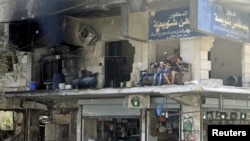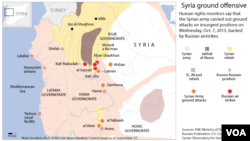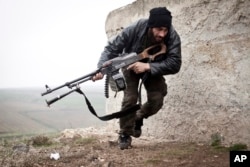The increasingly confused battlefield of northern Syria gives new meaning to the old saying that war makes for strange bedfellows.
With a dizzying array of vying armed groups, jihadists and Syrian government-aligned forces battling each other in multiple micro-conflicts, friend can become foe, and foe can turn into a temporary ally with alarming speed — depending on where clashes are occurring.
Certainly in the battles and skirmishes around Aleppo, Syria’s largest city and onetime commercial capital, the struggle is getting messier by the day.
Rebel commanders loudly accuse Damascus and Moscow of helping the Islamic State terror group with airstrikes meant to undermine insurgents in the countryside north of Aleppo, where rebels battling to oust President Bashar al-Assad have come under sustained and vicious assaults sometimes led by suicide bombers.
This is happening while insurgents are waging fierce battles south and southwest of the city to prevent government forces from encircling the rebel-held portion of Aleppo.
Meanwhile, Islamic State extremists managed this week to grab from government forces also south of Aleppo a 15-kilometer stretch of a highway linking Hama to Aleppo. IS won the three-day battle with at least indirect help, and possibly planned collaboration, from anti-government rebels led by al-Qaida affiliate Jabhat al-Nusra — or so Syrian government officials claim.
Regardless, by seizing part of the highway Monday between Khanaser and Ithriya, IS has succeeded in severing the Assad government’s last remaining land-based supply route into Aleppo. This helps anti-government rebels by undermining Damascus' offensive aimed at isolating them in their respective districts in the battered city.
Confusing battlelines
Both the anti-Assad rebels and the government are quick to accuse each other of collaborating with the Islamic State. But both, when it serves tactical military purposes, take advantage of the terror group's presence on the battlefield, if only indirectly.
And the Islamic State, in turn, has been opportunistically leveraging Russia’s intervention, quickly pressing an offensive that had stalled north of Aleppo on the rebel-held towns of Marea, Tal Rifat and Azaz.
A few days into the Russian air campaign, IS fighters launched a surprise advance just south of the border with Turkey. It was the most significant in months, enabling them to quickly seize the villages of Tal Qrah, Tal Sousin and Kfar Qares.
They also stormed a former army base known as the Infantry Academy that had been held by anti-Assad forces for two years. And they punched into an industrial zone in the northeast corner of Aleppo, a potential gateway into rebel districts in the city.
"The situation is now very difficult," said Abdul Rahman, a commander with the Ahfad Omer battalion, part of the larger First Brigade, a U.S.-backed secular militia.
"We are fighting both IS and Assad. When we gather to mount an attack on regime forces, ISIS comes and disrupts the assault, and at the same time the Russian warplanes arrive and attack us," he added.
Using the Arab acronym for IS, he joked, "Maybe we should try to negotiate a truce with Daesh, fight Assad and then come back to finish Daesh."
This is an unlikely suggestion from a fighter who has seen his own men die in battles with IS.
The micro-conflict north of Aleppo is crucial for the rebels; they need to hold their territory there to maintain supply lines running into Turkey.
"We are the only people who fought ISIS and pushed them from Aleppo," said Zakaria Malahefji, a spokesman for the 3,000-strong Fastaqim Kama Umirt, a brigade linked to the rebel alliance Jaish al-Mujahideen (Army of Holy Warriors).
"By not focusing on Assad and targeting him, the West is complicating the situation and is making it more dangerous for us," said Malahefji. "The West needs to understand that the main enemy has to be Assad; he is the one who helped create Daesh in the first place and is exporting terrorism to other countries including Turkey."
Self-fulfilling prophecy
The rebels have long argued that Assad has been playing a complex double game, using jihadists to act as fifth columnists, planning for them to effectively sabotage the revolution against him and color it as extremist.
The rebels point to Assad's early release of large numbers of jihadist prisoners at the start of the revolution, a maneuver to distort the rebellion and then be able to claim it was extremist in nature all along.
The rebels say the government has focused far more of its military efforts on them the past two years, often ignoring fighting IS altogether, and content to see it expand in eastern Syria and even parts of the center of the country.
In May the ease with which IS was able to seize the ancient city of Palmyra prompted some military observers to speculate Assad deliberately abandoned the site — with its unique ruins and irreplaceable ancient artifacts and treasures — to gain Western sympathy.
"The collaboration is clear at times between the Russians and the Assad regime with Daesh. Their offensive in the northern Aleppo countryside has increased in intensity with the aid of Russian airstrikes. They are working together on many front lines to put pressure on us," said Malahefji of Jaish al-Mujahideen.
"When ISIS tries to storm our positions, the Assad regime and the Russians back them with airstrikes and shelling," he added.
With the rebels bearing the brunt of the Russian-backed Assad offensives elsewhere, Malahefji warned that IS is being handed opportunities to capture still more ground, particularly in the contested area north of Aleppo. That is territory once earmarked by the West for a possible safe haven for Syrian refugees.
That may be so, but the attack by IS on the Aleppo-Hama highway hardly serves the government's objectives, and it was pulled off in an area the Islamist extremists have not been controlling and is more associated with anti-Assad rebels.
The government has not officially acknowledged the loss, but Syrian officials told VOA the seizure was only successful because IS militants attacked on one side of the road while rebel fighters allied to al-Qaida’s branch in Syria, Jabhat al-Nusra, a fierce rival of IS, were pressing on the other side.
They insist it was a coordinated assault. If true, it would be further testimony to the murkiness of a conflict where front lines are fluid, local deals are struck, and enemies can become allies overnight — and then revert to being enemies — in what U.S. Secretary of State John Kerry described earlier this year as a "huge sectarian mess."














